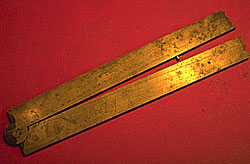 73. Twelve-inch sector
73. Twelve-inch sector
The sector was invented around 1600 and Galileo himself was interested in proportions in those very years. In the mid-XIXth century, three centuries after its discovery, the sector became obsolete to the point where, in 1866, William Stanley described it as "a kind of compulsory ornament" often still present in drawing cases.
In England the sector was already being used by surveyors at the end of the XVIth century. Only after was it produced with scales expressly designed for sailors, surveyors and draftsmen.
The sector was defined a universal scale and was used with a pair of fixed point compasses. The instrument consists of two rulers held together by a flat hinge so that movement was equal and uniform. The accuracy of the measurements depended on the precision with which the hinge was made. A series of diverging linear scales laid out symmetrically on each of the faces fans out from the rotational axis of the blades to their ends.
Similar therefore to a hinged compass, it was available in sizes 6, 9 and 12 inches. The exemplar in question - whose scales seem to be incomplete - belongs to the larger size. When extended its length doubles.
Its use is based on the principle of similar triangles: all that was necessary was to open the arms, transfer the measures in question, using a fixed point compass, from one scale to another and read the corresponding value.
J.A. Bennett (1987), p. 62.
N. Bion (1709), table 6.
M. Daumas (1953), pp. 17, 48, 49.
G.L’E. Turner (1991), p. 253.